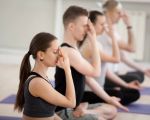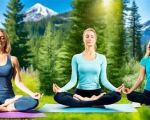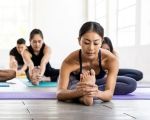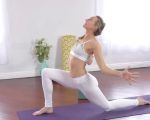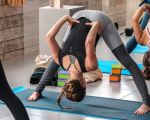- 1. What is Vinyasa Yoga and Why It’s Great for Beginners
- 2. Getting Started with Vinyasa Yoga: What You Need to Know
- 3. Common Vinyasa Yoga Poses for Beginners
- 4. Vinyasa Yoga Tips for Beginners: How to Improve Your Practice
- 5. The Importance of Breathing in Vinyasa Yoga
- 6. Developing the Right Mindset for Vinyasa Yoga
1. What is Vinyasa Yoga and Why It’s Great for Beginners
Vinyasa yoga is one of the most popular styles of yoga practiced today. Known for its flowing, dynamic movements that link breath with movement, Vinyasa is often referred to as “flow” yoga. The key to Vinyasa is that it emphasizes fluid transitions between poses, which creates a rhythmic and seamless experience. If you’re new to yoga, Vinyasa is an excellent choice because it offers flexibility, creativity, and a focus on the mind-body connection.
Unlike other yoga styles that may focus heavily on holding static poses, Vinyasa allows beginners to gradually learn the basics of breath control, flexibility, and balance in a gentle, yet invigorating way. The adaptability of Vinyasa means it can be adjusted for people of all levels, making it accessible for those just starting out on their yoga journey.
2. Getting Started with Vinyasa Yoga: What You Need to Know
As a beginner, starting with Vinyasa yoga can feel overwhelming at first, but once you understand the basic principles, it becomes easier and more enjoyable. Here’s what you should know before you start:
1. Understanding the Flow: In Vinyasa, each movement is tied to an inhale or exhale. For instance, in the sun salutation sequence, you’ll inhale to raise your arms and exhale as you fold forward. As a beginner, focus on following the breath and staying in the moment, rather than trying to master every pose right away.
2. Choosing the Right Class: If you’re new to yoga, look for classes labeled “Beginner Vinyasa” or “Vinyasa for Beginners.” These classes are specifically designed to guide newcomers through the basic poses and sequences at a comfortable pace. Don’t hesitate to let the instructor know you’re a beginner so they can offer modifications or adjustments during the class.
3. Prepare Your Body: Vinyasa yoga can be physically demanding, so be sure to prepare your body with a few basic stretches or warm-up exercises before class. You’ll need a yoga mat, comfortable clothing, and some water to stay hydrated throughout the session.
3. Common Vinyasa Yoga Poses for Beginners
In Vinyasa yoga, there are several common poses that form the foundation of the practice. Familiarizing yourself with these poses will help you feel more confident as you move through the class:
1. Downward-Facing Dog (Adho Mukha Svanasana): One of the most recognized poses in Vinyasa, Downward Dog helps stretch the hamstrings, strengthen the arms, and improve posture. Begin on your hands and knees, lifting your hips toward the ceiling and straightening your legs.
2. Plank Pose: Plank Pose is a great way to build strength in the core, arms, and shoulders. Start in a push-up position, keeping your body in a straight line from head to heels.
3. Cobra Pose (Bhujangasana): This pose stretches the spine and opens up the chest. Begin by lying on your stomach, then lift your chest off the floor using your hands while keeping your elbows close to your body.
4. Child’s Pose (Balasana): This restful pose is often used to relax and center yourself during a practice. Start by kneeling on the mat and folding forward, bringing your forehead to the ground while your arms extend in front of you.
4. Vinyasa Yoga Tips for Beginners: How to Improve Your Practice
While the flow of Vinyasa yoga can initially be challenging, there are several tips you can follow to improve your practice and maximize the benefits:
1. Focus on Your Breath: One of the main principles of Vinyasa yoga is coordinating your breath with your movement. If you’re ever unsure about what to do next, focus on your breathing. Deep, steady breaths will help you flow through the sequence and maintain energy.
2. Move at Your Own Pace: Don’t worry about keeping up with others in the class. Vinyasa can be fast-paced, but it’s important to listen to your body and take breaks when needed. Use Child’s Pose or Downward Dog to rest and catch your breath if necessary.
3. Modify Poses as Needed: Many Vinyasa yoga poses can be modified to fit your current level of flexibility and strength. Don’t be afraid to use blocks, straps, or other props to make poses more accessible. Your instructor can help guide you through these modifications.
4. Stay Consistent: Like any new skill, consistency is key. Try to practice Vinyasa yoga regularly, even if it’s just once or twice a week. With time, you’ll notice improvements in your flexibility, strength, and overall well-being.
5. The Importance of Breathing in Vinyasa Yoga
Breath is at the heart of Vinyasa yoga. In fact, the term “Vinyasa” translates to “arranging something in a special way,” and in yoga, this refers to the connection between movement and breath. Each inhale and exhale should correspond with a movement, allowing the body to flow gracefully from one pose to the next.
1. Ujjayi Breath: This is a common breathing technique used in Vinyasa yoga. It involves breathing deeply through the nose while slightly constricting the throat, creating a soft, audible sound. Ujjayi breath helps to control the flow of energy and maintain a steady rhythm throughout the practice.
2. Breath as a Tool for Focus: Breathing deeply and mindfully helps to calm the mind, making it easier to focus on the present moment. If your thoughts start to wander or you feel overwhelmed, return to your breath and take a few deep inhales and exhales to reset your focus.
6. Developing the Right Mindset for Vinyasa Yoga
Yoga is as much about mental and emotional growth as it is about physical strength. To get the most out of your Vinyasa practice, developing the right mindset is essential:
1. Patience and Self-Acceptance: Don’t be too hard on yourself if you don’t immediately nail every pose or sequence. Yoga is a practice, not a performance. Allow yourself the space to grow and improve over time.
2. Cultivate Mindfulness: Yoga teaches you to stay present in the moment, which can help you reduce stress and improve your mental well-being. Try to bring that mindfulness off the mat and into your everyday life.
3. Embrace the Journey: Progress in yoga happens over time. Rather than focusing solely on the end goal, embrace the journey of learning and growing in your practice. Celebrate small victories along the way and enjoy the process.
To further enhance your Vinyasa yoga journey, be sure to check out Free Yoga Links for the best yoga classes and resources that can help you deepen your practice and find new inspiration.

